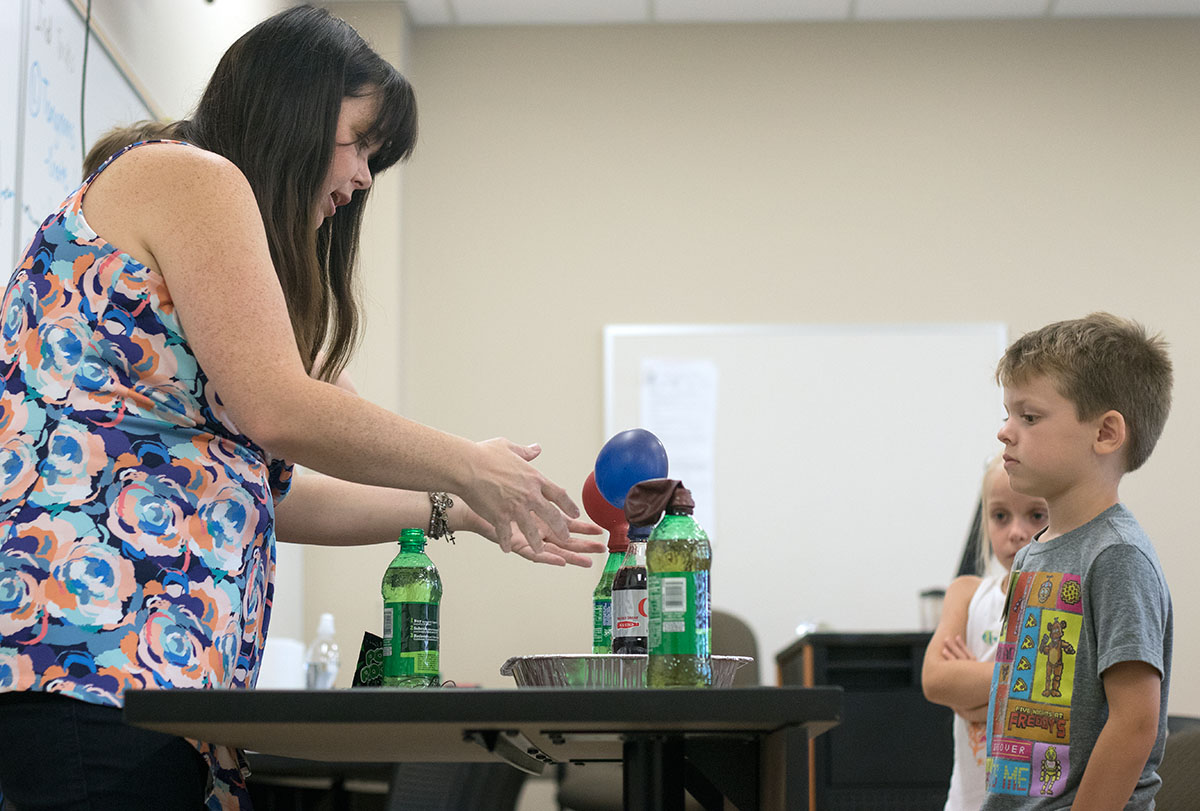By Erika Solberg
Wacky wordplay, oak trees, Chinese puzzles, cotton ball clouds, and peacock feathers: the tools being used by each instructor during Camp Explore varied, but what they have in common is their power to help students learn.
Camp Explore is a one-week, interdisciplinary day camp offered by The Center for Gifted Studies for students who have completed first through third grade. The 2017 edition of the camp features the theme “change” and offers hands-on, minds-on classes in language arts, math, science, art, and clowning. The first day of classes in Gary Ransdell Hall made clear that the students will spend a week with teachers who can use a variety of effective and powerful teaching strategies.

Mary Evans makes sure students have multiple options for activities in her language arts class. On Monday, after reading a book that featured alliteration and talking about what alliteration is, Mary asked the students to write and illustrate their own alliterations based on the structure used in the book. “You can do as many as you want,” she explained. “If you only want to do one or two, that’s fine. Some kids really like to draw and make elaborate pictures, but if you don’t, that’s okay. You can make a whole list of alliterations if you want. And after you do one, if you want to work on your own story, that’s fine too.” Giving students more than one way to complete a task and giving them multiple tasks from which to choose helps them stay engaged and allows them to take their learning in the direction that makes sense for them.
In math, instructor Allison Bemiss lets the students’ observations guide the discussion. As the students manipulated tangrams, a Chinese puzzle of seven shapes that can be put together to make bigger shapes and pictures, Allison asked questions and built on their discoveries.
One student called out, “Here’s a parallelogram!” so Allison asked what made it a parallelogram, then reviewed with the class the definition of parallel lines. She had the students cross their arms to depict lines that cross, and hold them straight at different angles to depict parallel lines. She also pointed out parallelograms on her brightly colored pants and asked where they saw parallel lines in the classroom.
Next, she challenged the students to make a square using all seven shapes. One student successfully made the square before the rest of the class, so Allison approached him and asked him to explain his strategy to her. He showed how he first created two right triangles and then put them together. She praised him and encouraged him to find a second way to make the square while the other students were still working. Another student struggled to find a solution but eventually called Allison over to show her work: she had used some of the pieces to make a square and sat the remaining pieces on top of the shape. “Innovative thinking,” Allison responded. “You went 3D!”

Art instructor Kaylynne Jones knows the importance of using a variety of methods to teach. She uses class discussions, stories, artists of the day, and daily hands-on activities to help students learn about the theme of “change.” On the first day of camp, her class sat on a blanket and looked at the G. Brian Karas’s picture book “As an Oak Tree Grows” which charts the life of an oak tree from the 1700s to the present day, as well as the world it inhabits. Studying the illustrations, Kaylynne and her students talked about how both trees and societies grow and change over time. They then looked at landscape paintings by Chinese artist Zhuang Nong and talked about what landscapes are. Finally, Kaylynne led them through a lesson on how to draw a tree, and the students drew their own trees on watercolor paper, the beginning of a landscape collage they will create all week.
For Andrea Heming, who teaches science, enthusiasm is a natural and essential part of teaching. On the first day of camp she had glue and glitter on her hands from helping the students create an illustration of types of clouds using paper, cotton balls, paint, and glue: she joked to the class, “We’re in a sticky situation!”
Later, one student, carefully teasing out the cotton on her paper, asked, “Is this wispy enough?”
“Yes, awesome!” Andrea replied.
Another student explained he’d moved his supplies around to better accommodate his work. “I put the glue there,” he said.
“Problem solver! I love it!” Andrea told him.
Andrea finished the lesson by reinforcing the concept of change and tying today’s learning to future lessons. “If you notice on here, clouds don’t stay the same. We learned in our book that wind affects how clouds are made. We’ll do wind later in the week,” she said. Her tone made it clear that the wind lesson would be just as fun as what they had done that day.
Sometimes, the most essential things a teacher can do are inspire and encourage. In one session of the Clowning class, instructor Nick Wilkins welcomed his first-day students in a bright-red Ringling Brothers T-shirt featuring a clown and the warning, “If he offers you pie, duck.” Despite the atmosphere Nick’s warm demeanor created, however, one student carried a fear of clowns with him into class, and at the beginning of the period was reluctant even to say his name. Soon, Nick wrote the word “Can’t” on the board. “We don’t use this word in here,” he told the kids with a grin. “Saying you ‘can’t’ is taking a step backwards. Saying you ‘can’ is taking a step forward.” By the end of the class period, the hesitant student stood with the rest of his classmates trying to balance a feather on his palm, the words “I can” seeming to float in the air above his smile.
